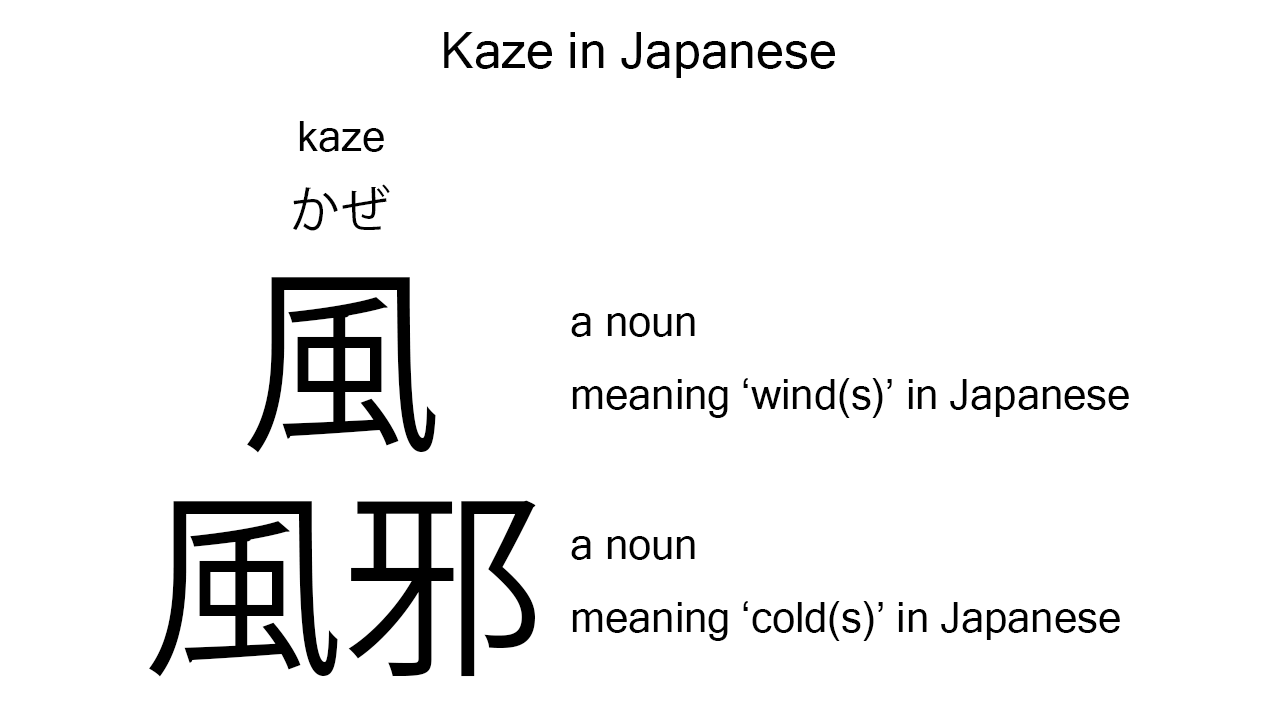What does “kaze” mean in Japanese?
Native speakers say “kaze” to mean ‘wind’ or ‘cold’ in Japanese. Perhaps, some Japanese learners know this word as it is sometimes used in Japanese conversations. In this blog post, however, I will explain this word in detail together with its kanji expressions. And also, I will explain how to use it through example sentences. My explanations would help Japanese learners understand “kaze” more clearly. Then, let’s get started!
Contents
Definition and meanings of “kaze”
Let me start with the definition and meanings of “kaze”.
- kaze – 風/風邪 (かぜ) : a noun meaning ‘wind’ or ‘cold’ in Japanese. This can also work as plural. Learn more about Japanese plural.
“Kaze” has two different kanji expressions. Japanese native speakers use the first one to refer to moving air; they use the second to refer to an illness. Unfortunately both have completely the same pronunciation, so we need to be careful with the context and situation.
The definition and meanings are not that difficult, I think. To understand this noun more clearly, however, let me explain its kanji characters in detail, one by one.
Kaze in kanji
The kanji expressions of “kaze” use the following two kanji characters:
- 風 : a kanji character widely used to mean ‘wind’ in Japanese.
- 邪 : a kanji character used to mean ‘evil’ in Japanese.
These two kanji characters tell us that the kanji character for ‘wind’ is used as it is and that a common illness is caused by an evil wind in Japanese.

When we meet new kanji expressions, we should check their kanji characters in detail to understand their meanings clearly and deeply. In many cases, kanji characters tell us a lot about the meanings of the expressions they form. Actually, here, we could get the better understanding of “kaze” through the detailed kanji check above.
So far, I’ve explained the definition and meanings of “kaze” together with its kanji expressions. Then, let me explain how to use it through the example sentences below.
Example #1: how to say “wind” in Japanese
kaze ga totemo atatakai desu – 風がとても温かいです (かぜがとてもあたたかいです)
The wind is very warm.
Below are the new words used in the example sentence.
- ga – が : a case particle used to make the subject word or the object word in a sentence. In the example, this is used after “kaze” to make the subject in the sentence.
- totemo – とても : an adverb of degree meaning ‘very’, ‘much’, ‘so’, or such in Japanese. In the example, this works before “atatakai” to emphasize its meaning.
- atatakai – 温かい (あたたかい) : an i-adjective meaning ‘warm’ in Japanese.
- desu – です : an auxiliary verb used after a noun or adjective to make it polite. Probably, this is well known as a part of Japanese desu form. In the example, this is used after “atatakai” to make it sound polite.
This is a typical usage of “kaze”. In this example, it means ‘wind’ and works together with the case particle, “ga”, to become the subject in the sentence.
Example #2: another usage of “kaze”
kanojo wa kaze ni nat ta – 彼女は風邪になった (かのじょはかぜになった)
She caught a cold.
Below are the new words used in the example sentence.
- kanojo – 彼女 (かのじょ) : a pronoun meaning ‘she’ in Japanese.
- wa – は : a binding particle working as a case marker or topic marker. In the example, this works after “kanojo” to make the subject in the sentence.
- ni – に : a case particle used to say what someone or something becomes after a change or action. In the example, this is used after “kaze” to indicate what “kanojo” became.
- nat – なっ : one conjugation of the verb, “naru”, which means ‘to become’, ‘to turn’, or such in Japanese. In the example, it has been conjugated for the better connection with its following word.
- ta – た : an auxiliary verb used after a verb, adjective, or auxiliary verb to make its past tense form. Probably, this is well known as a part of Japanese ta form. In the example, this is used after “nat” to make its past tense form, “nat ta”.
This is another typical usage of “kaze”. In this example, it works as a part of the commonly-used phrase, “kaze ni nat ta”, which literally means ‘became a cold’ in Japanese. It is often translated into English as ‘caught a cold’, though.
Summary
In this blog post, I’ve explained the definition and meanings of “kaze” in detail together with its kanji expressions. And also, I’ve explained how to use it through the example sentences. Let me summarize them as follows.
- kaze – 風/風邪 (かぜ) : a noun meaning ‘wind’ or ‘cold’ in Japanese. This can also work as plural. Japanese native speakers use the first kanji expression to refer to moving air; they use the second to refer to an illness. Unfortunately both have completely the same pronunciation, so we need to be careful with the context and situation.
Hope my explanations are understandable and helpful for Japanese learners.